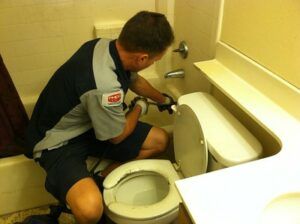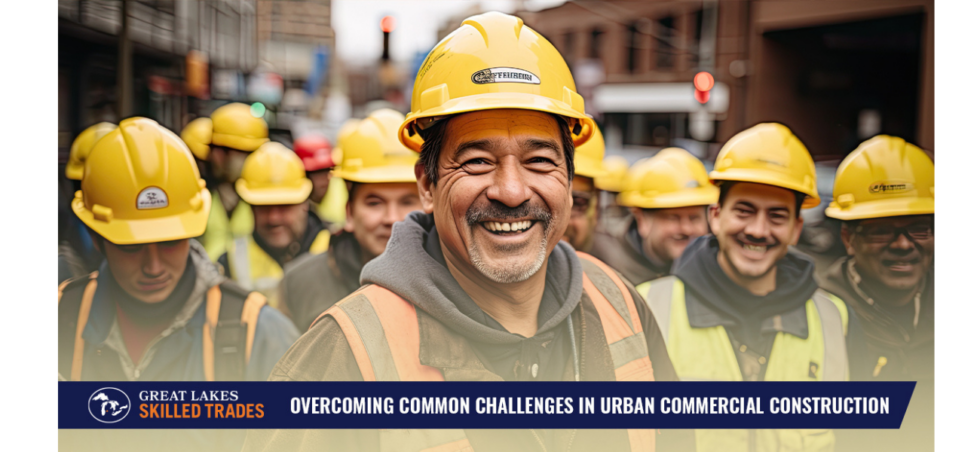In America, it’s a given that any structure you’re in—certainly your domicile—will have “hot and cold running water.”
Hence the necessity of plumbers, the ones who install all those pipes, fixtures, and appliances in homes, commercial buildings, and factories.
That means a plumber needs to know how to interpret blueprints, determining the materials and processes needed at a jobsite. And when something goes wrong, they’re the ones called on to troubleshoot the problem and fix it.
It’s a physical job, crawling into tight spaces—or climbing to high places—and wrenching things into place.
Cerebral too, as you’ll need a grasp of basic algebra. For example, every plumber knows The 45-Degree Formula for connecting two pieces of pipe. To wit: Take the center measurement between the two pipes and multiply it by the constant 1.414. The length of the two fittings is then subtracted from the original answer. Yeah, if you didn’t pay attention in your high school math classes, you’re probably going to need a refresher before you start your journey to becoming a plumber!
But if you can make it through all the training and pass your licensing exams, you’ll be part of a stable and well-paid profession.
Ask Derrick Brown. He is founder/owner at Kent County Plumbing in the greater Grand Rapids area. He started his journey to becoming a plumber in 2003 in Illinois. In 2019, he formed Kent County Plumbing, and he’s been “on a roll” in the waning months of the pandemic. He owns his own home, and he and his wife plan to take their three kids to Disneyland this year. He plans to hire his first employee this year too.
“I love being a plumber. I’m proud to be a plumber,” Derrick says. “If you’re good with your hands—and people—and have high standards and a willingness to learn, you’d be a good fit.”
Intrigued?
The Bureau of Labor Statistics estimates that the plumbing industry will grow by 12% over the next 10 years, far in excess of the average for all occupations. Meanwhile, more and more plumbers will retire over the next decade. Some employers have already complained that they can’t find enough qualified plumbers.
In this post, we will look at what it takes to become a plumber and how much you can expect to earn. When you finish the post, you’ll have a better idea if it’s the career path you want to go down.
How much can you earn as a plumber?

The average hourly rate for plumbers across the entire United States is $25. That pencils out to a salary of around $50,000 a year, much higher than the national median income for all occupations, $36,200. Of course, the average plumber’s salary varies from region to region and depends on years of experience, but plumbers in certain metropolitan areas can earn over $80,000 every year.
Many commercial construction plumbers work a standard Monday-through-Friday schedule and enjoy weekends off. If you’re on the residential side, you’ll do more after-hours emergency calls, burst pipes, and such. Plumbers who own their business can choose the hours they work and enjoy being their own boss.
What kind of training do you need to become a plumber?

You’ll need a high school diploma or GED. With that in hand, you can receive training at a trade school or community college. Then you must complete an apprentice program, which can last four to five years.
An apprenticeship is an “earn while you learn situation” where you work at a jobsite during the days and head into a classroom for three to four hours of training one or two nights a week.
For his part, Derrick attended Illinois State University and earned a bachelor’s degree in business administration, but that was mainly “just to have the college experience.” He pretty much always knew he’d get into plumbing. That’s what happens your father and grandfather were both plumbers.
“When I was 8 years old, my dad would take me to work with him in the summers,” Derrick says. “It was more fun than anything, but at 15 I started working every day after school.”
The beauty of a plumbing career is that it doesn’t require you to amass a load of student debt. The average student loan debt owed per borrower is over $37,000. That’s $1.5 trillion in college debt across America. College debt outpaces all other kinds of debt in America, except for mortgages.
What does a plumber do?

Plumbers install and repair pipes that supply water and gas to—and carry waste away from—homes and businesses. They install plumbing fixtures—bathtubs, sinks, toilets, and such—as well as appliances, such as dishwashers and water heaters. They can be called on to cut holes in floors, ceilings, and walls and may need to hang steel supports from ceiling joists to hold pipes in place, which usually requires fitting, measuring, and cutting pipes to fit using pipe cutters and saws. Working with copper pipes may require soldering.
On any given day, a plumber could expect to . . .
- Install pipes and plumbing fixtures.
- Visually inspect equipment and operate test equipment—things like pressure and vacuum gauges—to determine the cause and location of trouble.
- Fix the clog! Clear obstructions from sink drains and toilets.
- Troubleshoot problems and decide how to fix them.
- Repair pipes and plumbing fixtures.
- Make cost estimates for installations and repairs.
- Present recommendations and related pricing to customers
One way to get started

A good entrée to a career as a plumber may be to work for a temporary firm as a plumber’s helper. It could give you a “taste” of the profession. Plumber’s helpers make sure that the tools needed to complete the job are available. They also prepare the work area for the plumber as well as cut new pipes, drill holes, assist with pipe removal, review blueprints, and maintain a working knowledge of worksite safety protocols.
Dustin Ide, vice president at Great Lakes Skilled Trades, says: “We haven’t yet put out any plumber’s helpers, but if the market asks for it, we’ll find the best person to fill the slot. Typically, if it is a large commercial job, a contractor will be looking for someone to have some basic plumbing or pipefitting experience, six-plus months typically, but I have also seen contractors take just a good construction laborer, someone who has experience on jobsites, and be willing to teach them as well.”
Did you like this post? You may also like:
Everything you need to know about becoming an electrician
Everything you need to know about becoming a welder
Everything you need to know about becoming a carpenter
Everything you need to know about becoming a roofer
Everything you need to know about becoming an HVAC tech
Everything you need to know about becoming a mason
Everything you need to know about becoming a painter
Was this blog post helpful for you? Why not subscribe to our blog? It’s free. Just input your email address below. We promise we won’t spam you. However, as our way of saying thanks for subscribing, we’ll send you our e-book, “4 Things to Consider When You’re Looking for a Temporary Staffing Firm.”
Subscribe








